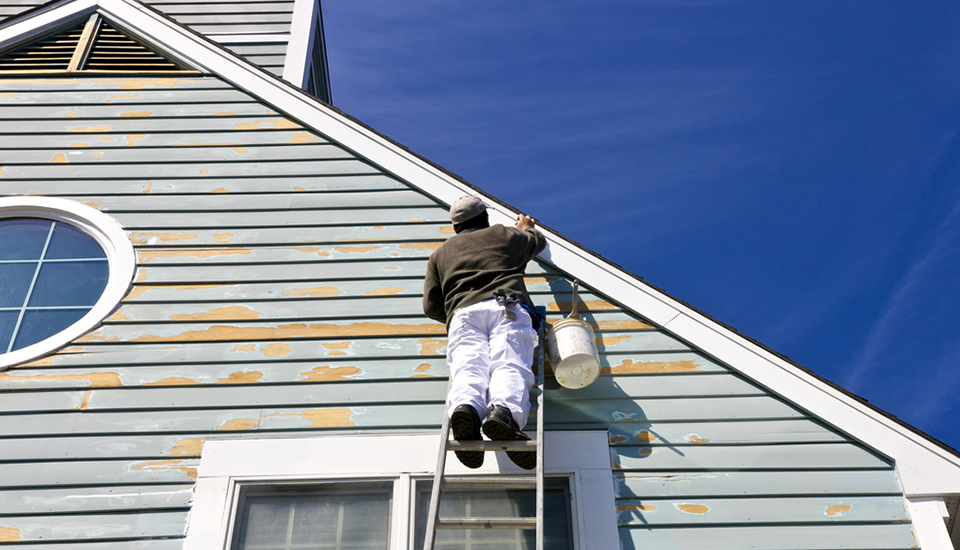It’s arguably the most important exterior feature of your house. Not only does your siding showcase the style of your home, making the strongest curb appeal statement, but your home’s structure relies on its protection. Old or damaged siding isn’t just an eyesore, reducing your home’s value. It also invites moisture damage and other serious problems.
Being able to recognize when it’s time to call a siding professional can potentially save you thousands in home repairs.
5 warning signs your house needs new siding
Homeowners can have a hard time determining whether their home’s siding needs a deep cleaning or if it’s time for a full-on replacement. Though some sidings may have a few distinct characteristics, there are five major red flags that apply across the board.
You’ll probably need a full replacement if your siding has any of these issues:
1. Cracking, fading, or peeling.
Cracked, faded, and peeled siding indicates signs of aging, often due to harsh sunlight and/or from frost and thaw cycles. Likewise, if your painted siding doesn’t seem to hold onto the paint well anymore, it’s a sign it’s time to replace it.
2. Damaged boards or panels.
Chances are high that any physical damage to the siding warrants a full replacement. In many cases, if widespread damage occurs, or the siding is left unrepaired for a long time, a simple board or panel repair isn’t likely to be an option. There may also be damage from insects, like termites, that have destroyed the wood siding on your home.
3. High energy bills.
Unseen gaps or holes in siding, as well as weakened or old insulation, will show themselves in the form of pricey electric bills every month. Save yourself some money and create a more controlled climate in your home. Get worn siding replaced and have additional insulation added if needed.
4. Interior wall damage.
Even if your siding looks great on the outside, water stains and/or loose wallpaper on your interior walls could point to siding issues. Interior damage is usually the sign of a serious problem and requires immediate action.
5. Mold growth.
Along with water stains on interior walls, rotting, mold/fungal growth, and anything else that points to progressive water damage is a surefire sign you need new siding. Warping or swelling may also occur in some materials. Moisture damage may show itself in the form of rust on steel siding.
If you’ve seen even one of these signs, consulting a professional is a safe bet. Typically, a contractor will inspect your home first to let you know if a repair is in order or if you need to consider a full siding replacement.
Find out if you can fund your repairs with a refinance.
How to pick new siding: Materials and cost
Think twice before residing your home in the same material:
- If your old siding failed: Then trying a more durable material (like stucco or brick veneer) could be a smarter decision.
- Also, consider whether you’d like a lower maintenance siding: For example, if you loved your previous wood siding but found it difficult to keep up on the restaining and sealing, opt for a superior alternative like modified wood siding. You can even reclad classic log veneer cabins in steel log siding.
And if you plan to sell in the near future, take what’s popular in your neighborhood into consideration, including new construction. Many new homes are being outfitted in stucco and fiber cement siding; using one of these materials could potentially boost your home’s value.
Though siding can be replaced any time of year, an ideal season is the fall:
- Autumn tends to have fairly stable temperatures: This time of year should be free of the heat spikes of summer and the bitter cold drops of winter.
- Also, replacing your siding in fall ensures optimum insulative value: As a homeowner, you’ll see both immediate and long-term rewards.
In some cases, homeowners in regions that get snow may not even have the option of full replacement in winter. So, be sure to plan ahead.
One more factor to consider when you’re looking at the siding is the replacement cost:
- Cost is going to vary depending on several factors: These include the type of siding you choose, what extras you need included (such as removal of old siding), and the size of your home. A two-story home may cost up to 20-percent more than a single-story.**
- For the average home: You can expect to pay up to $10,871**. Note that because of supply shortages, material costs have risen as much as 10 percent in the last year; delayed delivery times are also expected.
If your siding’s seen better days, it’s probably time to contact a professional to help you make sure the job’s done properly. They can guide you into making an informed decision on exactly what you need and in what style — and also provide a warranty.
‘This was the transaction from heaven.’
“I never in 22 years had such an easy and smooth refi ever!” Can refinancing with the right lender really feel this good? Our clients seem to think so. Prequalify to find out if refinancing could fund your home renovation.
*Refinancing could make a significant difference in the amount you pay each month. But there are other costs you should consider. Plus, your finance charges may be higher over the life of the loan.
For educational purposes only. Please contact your qualified professional for specific guidance.
Sources are deemed reliable but not guaranteed.

